Wai-Tat Fu's Lab Partners with STEAM Studio To Make STEM, Spatial Reasoning Fun
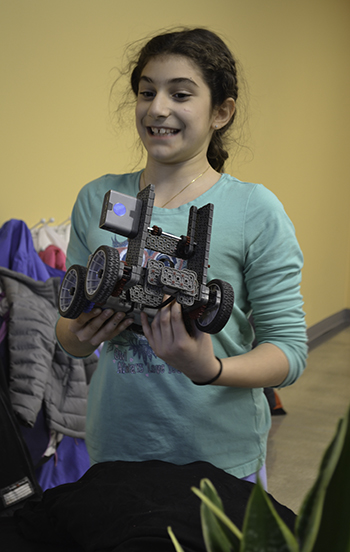 A STEAM Studio student from the Tera group has just finished trouble shooting a robot.
A STEAM Studio student from the Tera group has just finished trouble shooting a robot. February 21, 2017
Can exposing youngsters to technology that develops their spatial reasoning skills increase their chances of succeeding in STEM (Science, Technology, Engineering, and Mathematics) later on? Wai-Tat Fu, Associate Professor in Computer Science, and the students in his human-computer interaction lab are investigating the notion. So they recently partnered with STEAM Studio, Next Generation School’s after-school program, on a project that introduced kids in the Tera group to a couple of spatial-reasoning technologies, TinkerCad and 3D printing. But while the project might have been research for Fu and company, for the STEAM Studio kids, what could be more fun than playing with VEX robots, which they had built, on an obstacle course peppered with obstacles, which they had designed then 3D printed?
The first step in the project was to design the obstacle course. According to STEAM Studio director Angela Nelson, "I would say that spatial relations and reasoning really came in when they started to try and make an obstacle course, and they realized, ‘Well, first of all, where do we start? We have this robot, and how do we make something that is the right size, shape, design that it will actually function?'"
 A STEAM Studio participant (center) seeks to navigate a robot around a pillar on the obstacle course.
A STEAM Studio participant (center) seeks to navigate a robot around a pillar on the obstacle course. Nelson liked the idea that this next step in the project encouraged the youngsters to employ spatial reasoning skills as they made the mental jump from two dimensions to three.
"Now that we have this idea, what do we make it out of? If we’re going to use a 3D printer, what’s that process, and how do you take something that’s sitting on a piece of paper and make it into something you can actually see and use?"
Helen Wauck, a Ph.D. student in Fu’s lab, explains spatial reasoning as “how you perceive other objects in your environment relative to yourself."
"Can you imagine how that 3D object would look in your mind if you rotate it a certain way?" she continues. "Also, task related to navigation. How would this room look if I was standing over there facing a different direction as opposed to if I was standing here?"
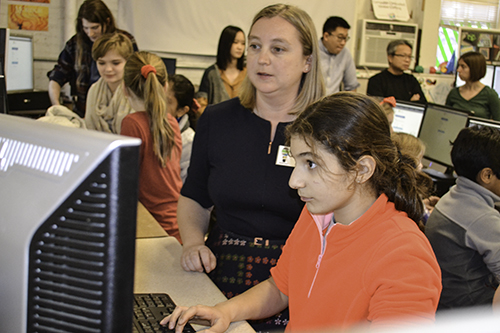 STEAM Studio director Angela Nelson (center) watches as a student uses TinkerCAD to design a figure that she will then 3D print at the Fab Lab.
STEAM Studio director Angela Nelson (center) watches as a student uses TinkerCAD to design a figure that she will then 3D print at the Fab Lab. To help the kids visualize these different perspectives, the project introduced them to TinkerCAD, a kid-friendly CAD (Computer-Aided-Design) software, via which the youngsters could learn some of the intricacies of 3D design. As part of the training, they also visited the Champaign-Urbana Community Fab Lab, where they learned all about 3D printing.
Then, once the obstacles they designed had been 3D printed, on February 16th, during a special final session the kids tested the robots they had built to see how well they could navigate the course. To add to the fun (and bedlam!), several groups of younger STEAM Studio students were invited to attend the event so they could learn a bit of what the older kids had experienced.
Why did Fu and his students get involved in the partnership with STEAM Studio? Fu acknowledges that one facet of his lab’s research at the intersection of cognitive science, AI, and human-computer interaction, targets Educational Technology.
 Above: Wai-TAt Fu, (left) and a couple of his students (in the background( look on as STEAM Studio youngsters make designs via TinkerCAD.
Above: Wai-TAt Fu, (left) and a couple of his students (in the background( look on as STEAM Studio youngsters make designs via TinkerCAD. “We are particularly interested in this project in early education and how we can use technology to help children to build a better foundation for science learning, and also skills that we believe are essential for them to be interested in science and engineering.”
So he contacted STEAM Studio about collaborating on a project that would expose the children to some cutting-edge technologies. The collaboration is part of a bigger project: Fu and company are writing a proposal to the National Science Foundation’s Cyber Learning and Future Learning Technologies divisions about using 3D printing and other activities to help prepare elementary students for STEM. Fu claims that they are especially focusing on spatial reasoning to “see to what extent we can train spatial reasoning in ways that we can actually find evidence that is supporting later STEM education and learning and the capacity to be interested in various disciplines of science.”
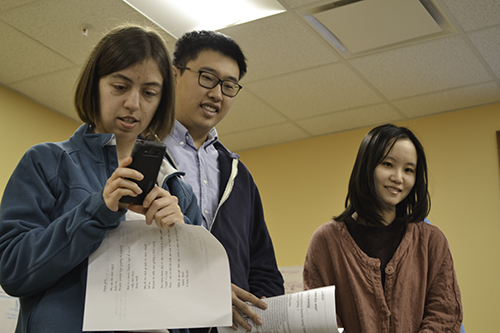 Left to right: Helen Wauck, Ziang Xiao, and Yuqi Yao enjoy watching the children during the project final event at STEAM STudio.
Left to right: Helen Wauck, Ziang Xiao, and Yuqi Yao enjoy watching the children during the project final event at STEAM STudio. So the premise of this project is that spatial reasoning skills are important for future success in STEM. And according to Helen Wauck, "Those spatial reasoning abilities have been shown to be highly correlated for success in STEM majors and STEM careers.”
Plus, one would expect Wauck to be particularly interested in the TinkerCAD aspect of the project, because as part of her research in this area, Wauck is studying game-based interventions. She says, “Because quite a few commercial games that weren’t designed to do this have been shown to train spatial reasoning skills. So we want to figure out what makes them tick.”
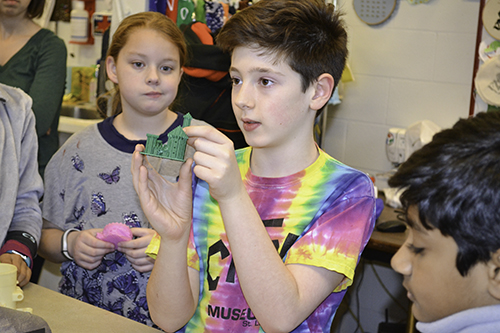 A student discusses a 3D-printed object during one of the Fab Lab sessions.
A student discusses a 3D-printed object during one of the Fab Lab sessions. Are there certain games that she says are the best? Portal “a new genre of spatial brain teasers” by Valve. Wauck describes it as a first-person puzzle game: “You shoot portals at walls, and then you can hop through the portal and come out somewhere else. You basically solve all of these physical puzzles that way.”
According to another of Fu’s students, Ziang Xiao, a first-year PhD Student in Computer Science, “We already know the spatial reasoning skill is very important for the future success of the student,” he says, “We want to find if there are any other [skills] so we can intervene as early as possible to clear the obstacles for the children to get into the STEM field.”
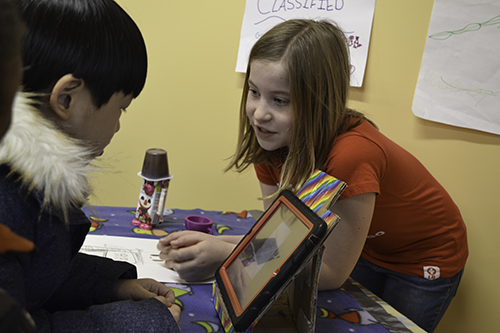 One of the older Tera students explains something to a younger STEAM Studio student at one of the exhibits at the project final event.
One of the older Tera students explains something to a younger STEAM Studio student at one of the exhibits at the project final event. Yuqi Yao, a Research Assistant in Dr. Fu’s lab, a recent Illinois graduate in Developmental Psychology, is interested in children’s education and spatial thinking. She feels this collaboration with STEAM Studio is “a perfect opportunity for me to get my concentration deeper.”
While some of the younger children appeared to be having some trouble being able to read complicated models, Yao doesn’t think it’s because they lack of spatial skills. “It’s more likely due to their lack of practice," she says. “This is giving them the opportunity to practice a skill that they already have, but they never got to explore before.”
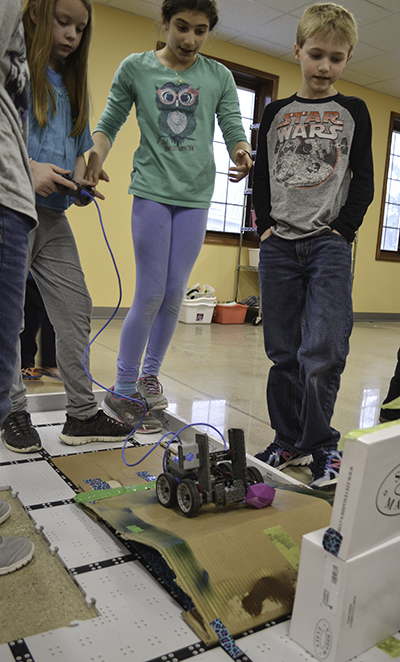 STEAM Studio students watch as their robot navigates the obstacle course they designed.
STEAM Studio students watch as their robot navigates the obstacle course they designed. STEAM Studio director Angela Nelson was pleased that the project exposed her students to so many aspects of STEAM. Of course, the robotics aspect addressed a couple of different engineering disciplines. She felt the spatial reasoning and 3D printing: "really grew their conception of the process and the connection between the different STEM fields from art."
The project also addressed science, technology, and math too: "I would say even if we go as far as STEAM—to the technology of their robots and the tinker CAD to the science of evaluating the device. So all of that came in, as well as the math. They calculated the dimensions of their obstacle course. They looked at the speeds of their robots. So all of those pieces interconnected."
According to Nelson that's one of their goals at STEAM Studio, to emphasize that all of the disciplines that comprise STEAM are interconnected:
"That’s something that we’re really encouraging, is that each letter of STEM doesn’t work on its own. It is a process that they come together and start to see a bigger purpose— something like this obstacle course allowed them to see a larger purpose."
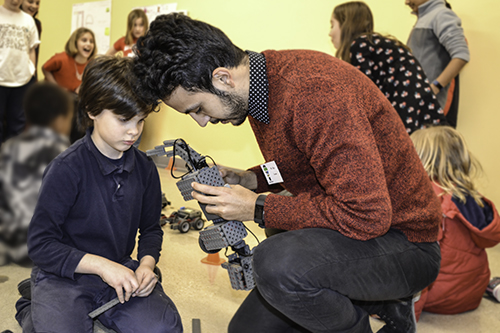 A STEAM Studio teacher helps a participant trouble shoot his robot.
A STEAM Studio teacher helps a participant trouble shoot his robot.
Story and photos by Elizabeth Innes, Communications Specialist, I-STEM Education Initiative.
For additional stories about STEAM Studio, see:
- STEAM Studio's STEAMcation Students Visit RailTEC...Learn All About Trains
- Illinois' MCBees Expose STEAM Studio's STEAMcation Students to Medieval Science
For more related stories, see: Faculty Feature, Next Generation School, STEAM Studio, K-12 Outreach, K-6 Outreach, CU Community, 2017
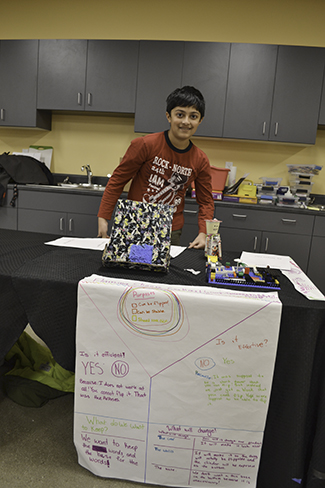 A Tera student mans an exhibit at the final obstacle course open house.
A Tera student mans an exhibit at the final obstacle course open house.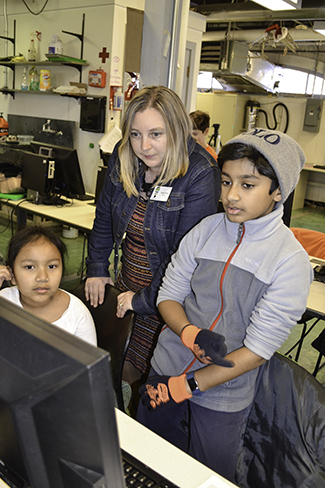 Angela Nelson (center) works with two students on an issue with their TinkerCAD 3D design.
Angela Nelson (center) works with two students on an issue with their TinkerCAD 3D design.  Members of Fu's lab watch as STEAM Studio students use TinkerCAD to create an object for 3D printing.
Members of Fu's lab watch as STEAM Studio students use TinkerCAD to create an object for 3D printing. 












.jpg)
















